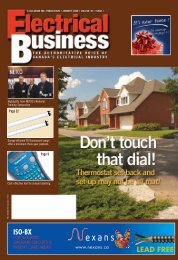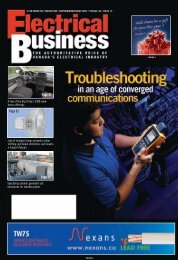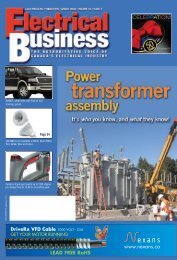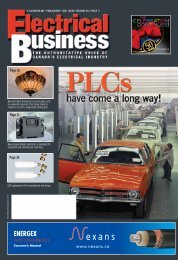Download - Electrical Business Magazine
Download - Electrical Business Magazine
Download - Electrical Business Magazine
Create successful ePaper yourself
Turn your PDF publications into a flip-book with our unique Google optimized e-Paper software.
fuses limited this fault current to amuch lower value and cleared thiscircuit in about 1⁄4 cycle or less.The following results wererecorded from the various sensorson the mannequin closest to thearcing fault. T1 and T2 recordedthe temperature on the bare handand neck, respectively. The handwith T1 sensor was very close tothe arcing fault. T3 recorded thetemperature on the chest underthe cotton shirt. P1 recorded thepressure on the chest. And thesound level was measured at theear. Some results “pegged themeter”, meaning the specificmeasurements were unable to berecorded in some cases becausethe actual level exceeded therange of the sensor/recordersetting. These values are shown as(>), which indicates the actualvalue exceeded the value given,but it’s unknown how high of alevel the actual value attained.Conclusions drawnfrom testingA couple of conclusions can bedrawn from this testing.First, arcing faults can releasetremendous amounts of energy inmany forms in a very short period.Look at all the measured valuescompared to key thresholds ofinjury for humans given in theparagraph above. Test 4 wasprotected by a 640-amp, noncurrent-limiting device thatopened in 6 cycles or 0.1 s.Second, the overcurrentprotective device’s characteristicscan have a significant impact onthe outcome. A 601-amp, currentlimitingOCPD protects the circuitin Test 3. The current that flowedwas reduced (limited) and theclearing time was 1⁄2 cycle or less.This was a significant reductioncompared to Test 4.Compare the Test 3 measuredvalues to the key thresholds ofinjury for humans, then the Test 4results. The measured results ofTest 1 are significantly less thanthose in Test 4, and even those inTest 3. The reason is that Test 1employed a much smaller(30-amp), current-limiting device.Tests 3 and 1 both show there arebenefits to using current-limitingOCPDs. Test 1 just proves thepoint that the greater the currentlimitation,the more the arcingfault energy may be reduced.Both Test 3 and Test 1 employedcurrent-limiting fuses, but thelower amp-rated fuses limit thecurrent more than the larger ampratedfuses. It is important to notethe fault current must be in the currentlimitingrange of the overcurrent protectivedevice to receive the benefit of the lowercurrent let-through. See the diagram (Figure 5)depicting the oscillographs of Test 4, Test 3 andTest 1.This article is based on parts of the CooperBussmann document, “Selecting ProtectiveDevices” © 2010.Eaton_EB_April10.indd 1<strong>Electrical</strong><strong>Business</strong>Visit www.EBMag.comand click to start your experience!is alsoDigital!Please call John MacPherson @ 905-713-4335or Scott Hoy @ 905-726-4664for Online Edition sponsorship opportunities!3/18/10 4:42:15 PMwww.EBMag.com • April 2010 • 21

















